for panel FORD TRANSIT 2021 Owners Manual
[x] Cancel search | Manufacturer: FORD, Model Year: 2021, Model line: TRANSIT, Model: FORD TRANSIT 2021Pages: 509, PDF Size: 8.21 MB
Page 9 of 509

Under Hood Overview - 3.5L Duratec
.......................................................................280
Under Hood Overview - 3.5L Ecoboost™ ........................................................................\
.
281
Engine Oil Dipstick - 3.5L Duratec ........
282
Engine Oil Dipstick - 3.5L Ecoboost™ ........................................................................\
282
Engine Oil Check .........................................
282
Changing the Engine Oil and Oil Filter ........................................................................\
283
Oil Change Indicator Reset .....................
284
Changing the Engine Air Filter ...............
284
Engine Cooling Fan ....................................
285
Engine Coolant Check ..............................
285
Automatic Transmission Fluid Check ........................................................................\
289
Brake Fluid Check ......................................
290
Changing the 12V Battery ........................
290
Adjusting the Headlamps ........................
293
Washer Fluid Check ...................................
294
Fuel Filter .......................................................
294
Checking the Wiper Blades ....................
294
Changing the Front Wiper Blades ........
295
Removing a Headlamp .............................
295
Changing a Bulb .........................................
296
Drive Belt Routing - Vehicles With: Dual Generators .................................................
301
Drive Belt Routing - Vehicles With: Single Generator ...................................................
301
Vehicle Care
Cleaning Products ......................................
302
Cleaning the Exterior .................................
303
Waxing ...........................................................
304
Cleaning the Engine ..................................
304
Cleaning the Windows and Wiper Blades ........................................................................\
305
Cleaning the Interior ..................................
305
Cleaning the Instrument Panel and Instrument Cluster Lens ......................
307
Repairing Minor Paint Damage .............
308Cleaning the Wheels
.................................
308
Vehicle Storage ...........................................
308
Body Styling Kits ..........................................
310
Wheels and Tires
General Information ....................................
311
Tire Sealant and Inflator Kit .....................
312
Tire Care ..........................................................
315
Using Winter Tires ......................................
332
Using Snow Chains ....................................
333
Tire Pressure Monitoring System ..........
334
Changing a Road Wheel ..........................
339
Lug Nuts .........................................................
350
Capacities and Specifications
Engine Specifications - 3.5L Duratec ........................................................................\
352
Engine Specifications - 3.5L Ecoboost™ ........................................................................\
353
Motorcraft Parts - 3.5L Duratec ............
354
Motorcraft Parts - 3.5L Ecoboost™ .....
355
Vehicle Identification Number ...............
356
Transmission Code Designation ............
357
Capacities and Specifications - 3.5L Duratec .......................................................
358
Capacities and Specifications - 3.5L Ecoboost™ ...............................................
363
Bulb Specification Chart .........................
369
Connected Vehicle
What Is a Connected Vehicle ...................
371
Connected Vehicle Requirements .........
371
Connected Vehicle Limitations ...............
371
Connecting the Vehicle to a Mobile Network .......................................................
371
Connecting the Vehicle to a Wi-Fi Network ......................................................
372
Connected Vehicle – Troubleshooting - Vehicles With: Modem ..........................
372
6
2021 Transit (TTH) Canada/United States of America, MK3J 19A321 AA enUSA, Edition date: 202010, Second-Printing Table of Contents
Page 39 of 509
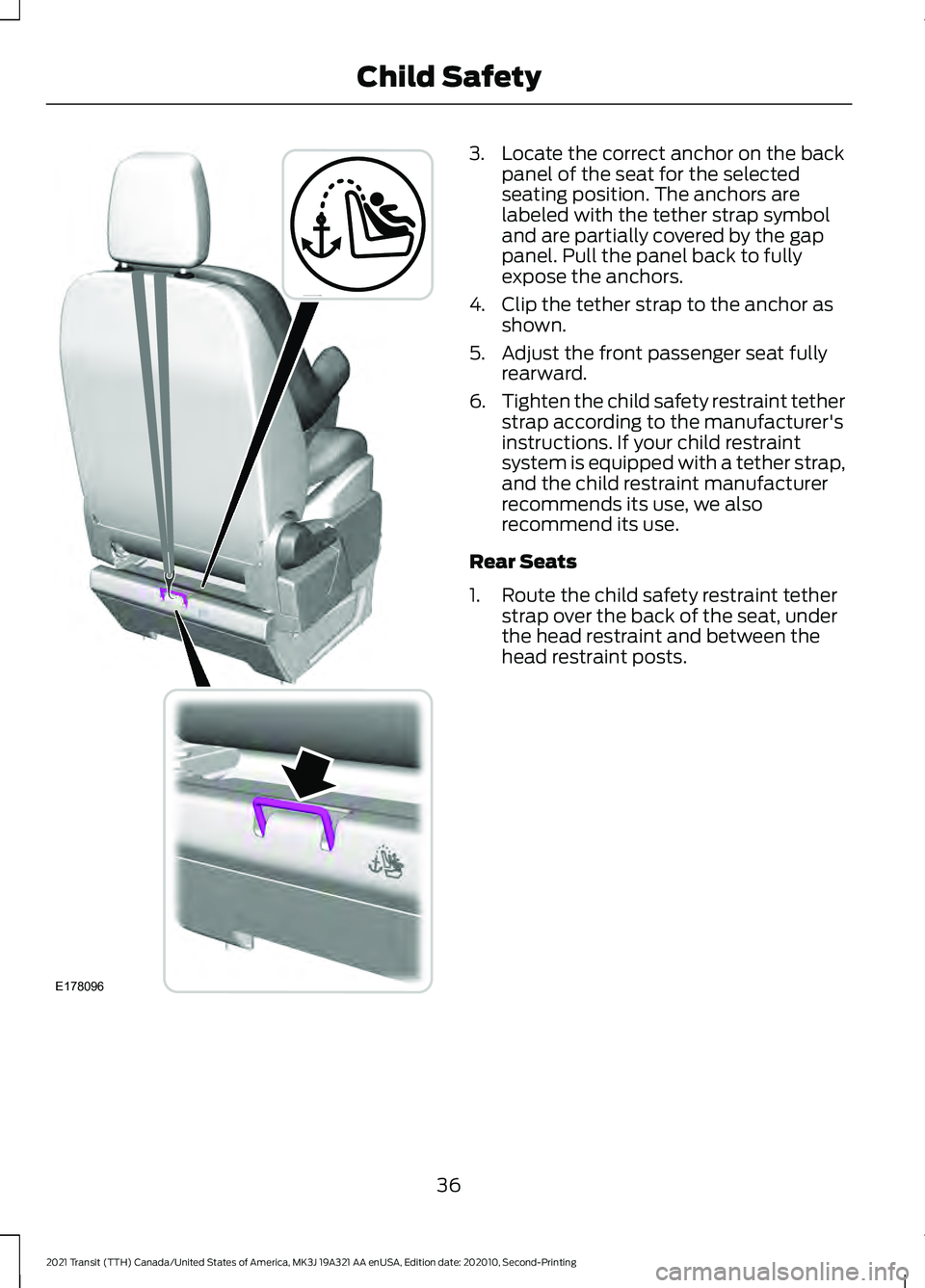
3. Locate the correct anchor on the back
panel of the seat for the selected
seating position. The anchors are
labeled with the tether strap symbol
and are partially covered by the gap
panel. Pull the panel back to fully
expose the anchors.
4. Clip the tether strap to the anchor as shown.
5. Adjust the front passenger seat fully rearward.
6. Tighten the child safety restraint tether
strap according to the manufacturer's
instructions. If your child restraint
system is equipped with a tether strap,
and the child restraint manufacturer
recommends its use, we also
recommend its use.
Rear Seats
1. Route the child safety restraint tether strap over the back of the seat, under
the head restraint and between the
head restraint posts.
36
2021 Transit (TTH) Canada/United States of America, MK3J 19A321 AA enUSA, Edition date: 202010, Second-Printing Child SafetyE178096
Page 40 of 509
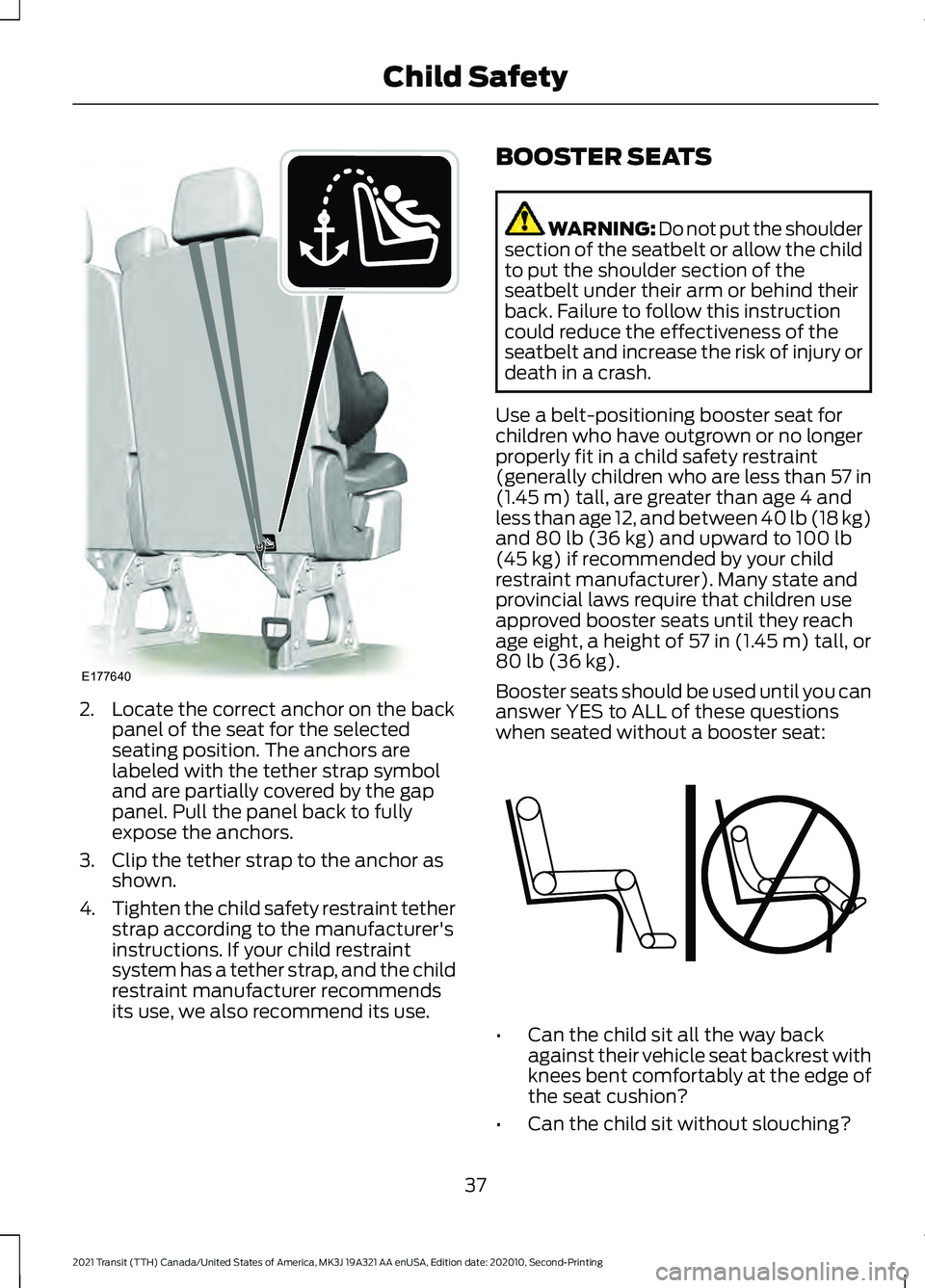
2. Locate the correct anchor on the back
panel of the seat for the selected
seating position. The anchors are
labeled with the tether strap symbol
and are partially covered by the gap
panel. Pull the panel back to fully
expose the anchors.
3. Clip the tether strap to the anchor as shown.
4. Tighten the child safety restraint tether
strap according to the manufacturer's
instructions. If your child restraint
system has a tether strap, and the child
restraint manufacturer recommends
its use, we also recommend its use. BOOSTER SEATS WARNING: Do not put the shoulder
section of the seatbelt or allow the child
to put the shoulder section of the
seatbelt under their arm or behind their
back. Failure to follow this instruction
could reduce the effectiveness of the
seatbelt and increase the risk of injury or
death in a crash.
Use a belt-positioning booster seat for
children who have outgrown or no longer
properly fit in a child safety restraint
(generally children who are less than 57 in
(1.45 m) tall, are greater than age 4 and
less than age 12, and between 40 lb (18 kg)
and
80 lb (36 kg) and upward to 100 lb
(45 kg) if recommended by your child
restraint manufacturer). Many state and
provincial laws require that children use
approved booster seats until they reach
age eight, a height of
57 in (1.45 m) tall, or
80 lb (36 kg).
Booster seats should be used until you can
answer YES to ALL of these questions
when seated without a booster seat: •
Can the child sit all the way back
against their vehicle seat backrest with
knees bent comfortably at the edge of
the seat cushion?
• Can the child sit without slouching?
37
2021 Transit (TTH) Canada/United States of America, MK3J 19A321 AA enUSA, Edition date: 202010, Second-Printing Child SafetyE177640 E142595
Page 55 of 509
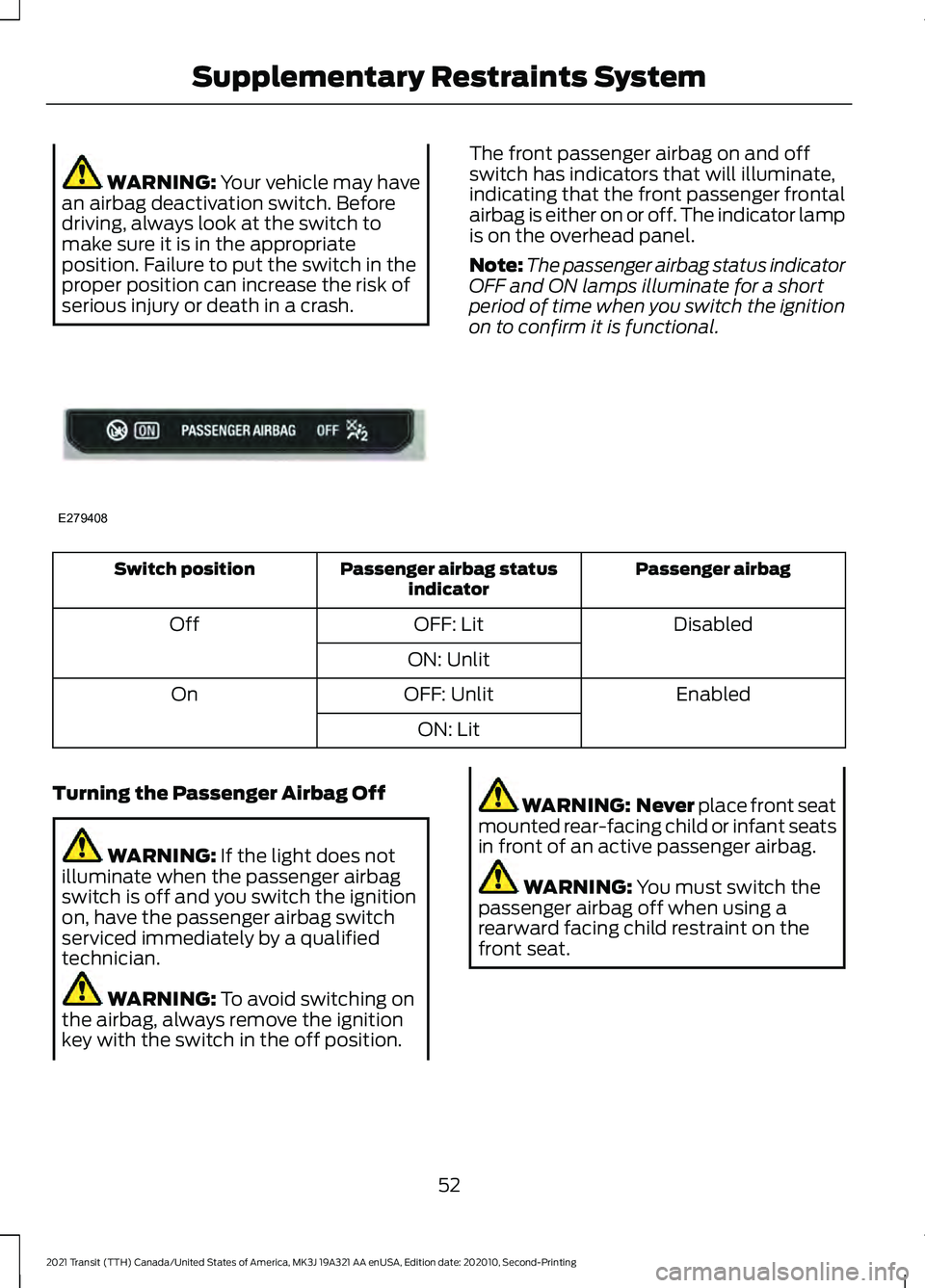
WARNING: Your vehicle may have
an airbag deactivation switch. Before
driving, always look at the switch to
make sure it is in the appropriate
position. Failure to put the switch in the
proper position can increase the risk of
serious injury or death in a crash. The front passenger airbag on and off
switch has indicators that will illuminate,
indicating that the front passenger frontal
airbag is either on or off. The indicator lamp
is on the overhead panel.
Note:
The passenger airbag status indicator
OFF and ON lamps illuminate for a short
period of time when you switch the ignition
on to confirm it is functional. Passenger airbag
Passenger airbag status
indicator
Switch position
Disabled
OFF: Lit
Off
ON: Unlit Enabled
OFF: Unlit
On
ON: Lit
Turning the Passenger Airbag Off WARNING:
If the light does not
illuminate when the passenger airbag
switch is off and you switch the ignition
on, have the passenger airbag switch
serviced immediately by a qualified
technician. WARNING:
To avoid switching on
the airbag, always remove the ignition
key with the switch in the off position. WARNING: Never
place front seat
mounted rear-facing child or infant seats
in front of an active passenger airbag. WARNING:
You must switch the
passenger airbag off when using a
rearward facing child restraint on the
front seat.
52
2021 Transit (TTH) Canada/United States of America, MK3J 19A321 AA enUSA, Edition date: 202010, Second-Printing Supplementary Restraints SystemE279408
Page 60 of 509
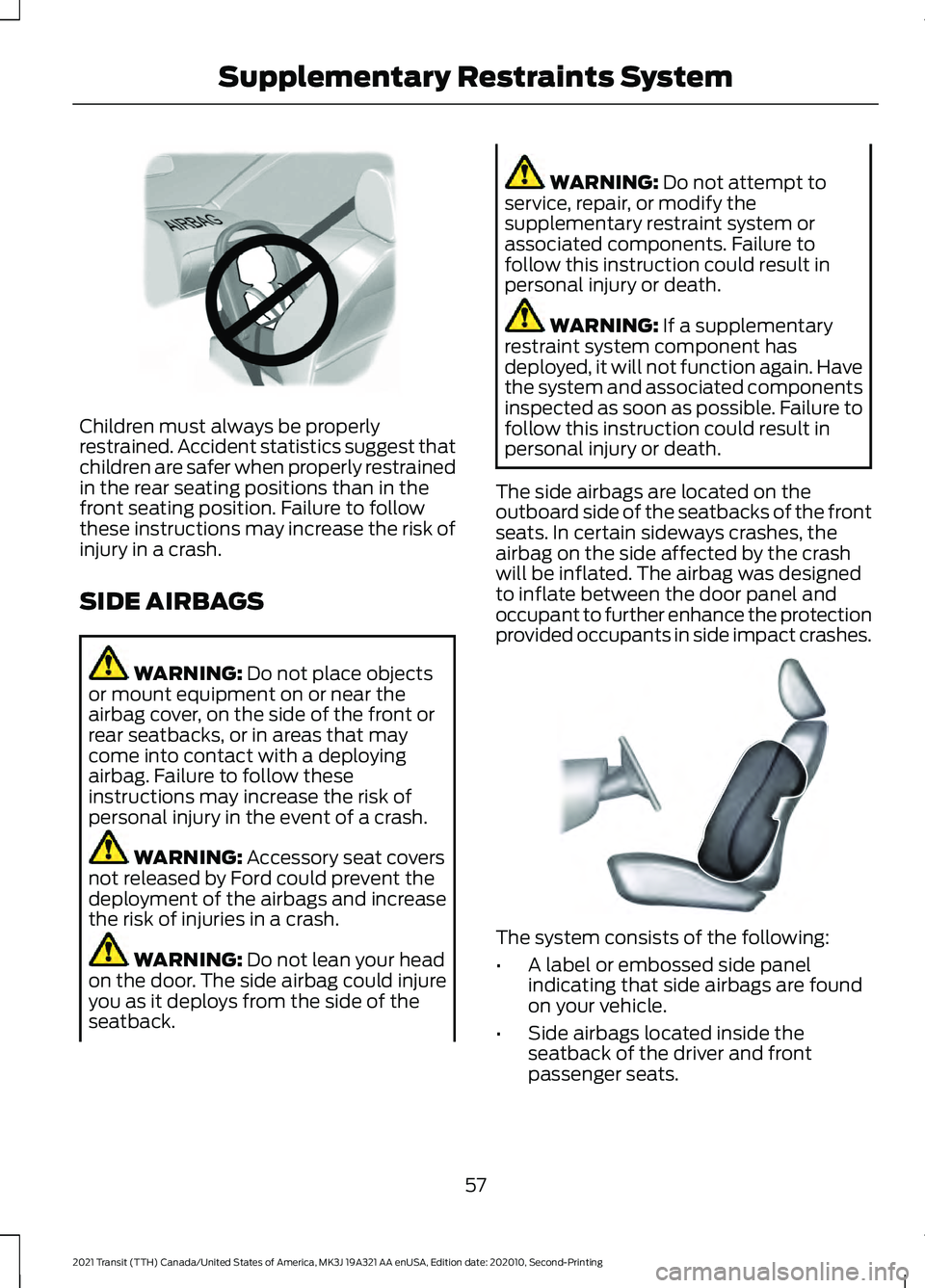
Children must always be properly
restrained. Accident statistics suggest that
children are safer when properly restrained
in the rear seating positions than in the
front seating position. Failure to follow
these instructions may increase the risk of
injury in a crash.
SIDE AIRBAGS
WARNING: Do not place objects
or mount equipment on or near the
airbag cover, on the side of the front or
rear seatbacks, or in areas that may
come into contact with a deploying
airbag. Failure to follow these
instructions may increase the risk of
personal injury in the event of a crash. WARNING:
Accessory seat covers
not released by Ford could prevent the
deployment of the airbags and increase
the risk of injuries in a crash. WARNING:
Do not lean your head
on the door. The side airbag could injure
you as it deploys from the side of the
seatback. WARNING:
Do not attempt to
service, repair, or modify the
supplementary restraint system or
associated components. Failure to
follow this instruction could result in
personal injury or death. WARNING:
If a supplementary
restraint system component has
deployed, it will not function again. Have
the system and associated components
inspected as soon as possible. Failure to
follow this instruction could result in
personal injury or death.
The side airbags are located on the
outboard side of the seatbacks of the front
seats. In certain sideways crashes, the
airbag on the side affected by the crash
will be inflated. The airbag was designed
to inflate between the door panel and
occupant to further enhance the protection
provided occupants in side impact crashes. The system consists of the following:
•
A label or embossed side panel
indicating that side airbags are found
on your vehicle.
• Side airbags located inside the
seatback of the driver and front
passenger seats.
57
2021 Transit (TTH) Canada/United States of America, MK3J 19A321 AA enUSA, Edition date: 202010, Second-Printing Supplementary Restraints SystemE142846 E152533
Page 62 of 509
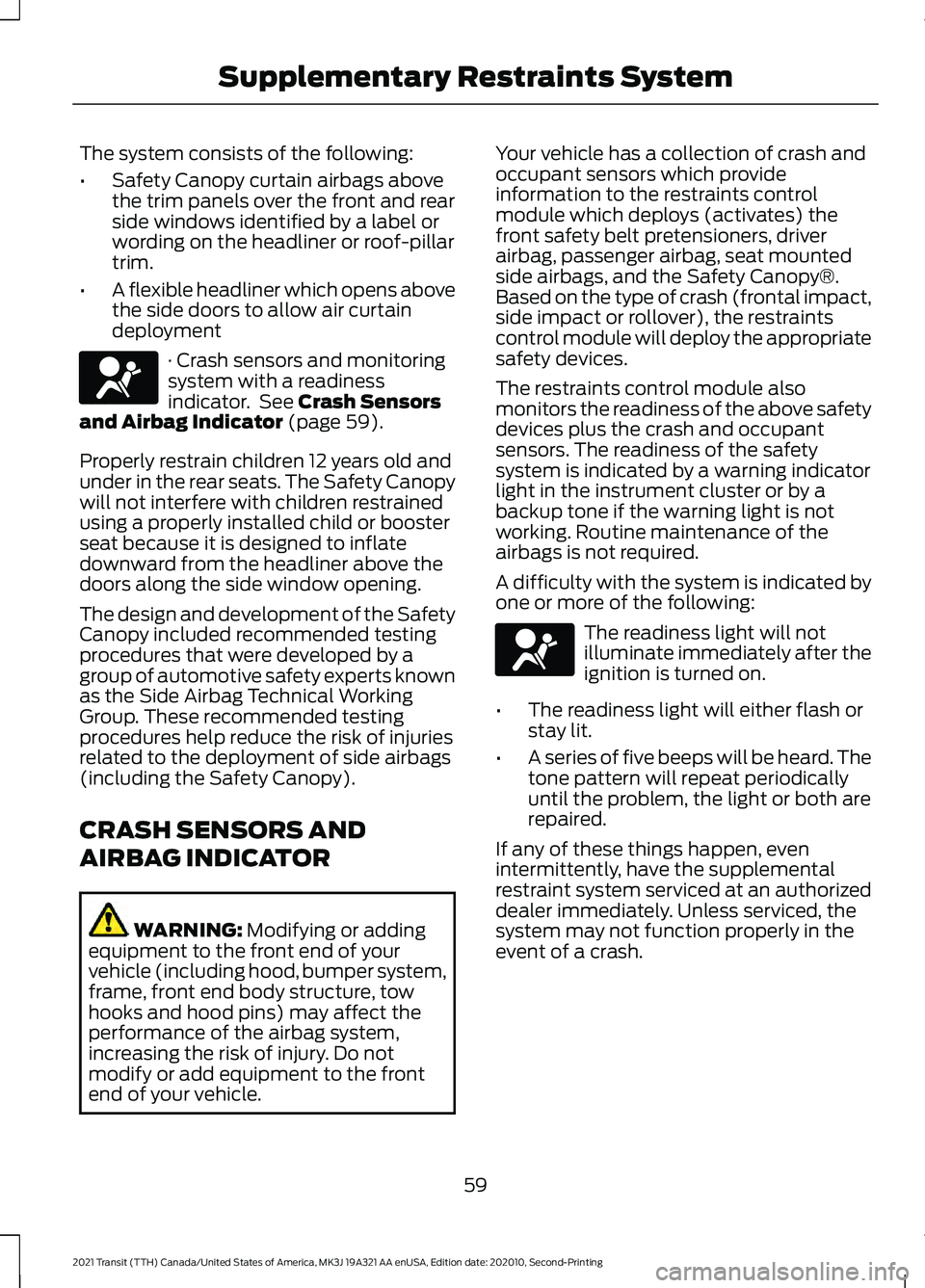
The system consists of the following:
•
Safety Canopy curtain airbags above
the trim panels over the front and rear
side windows identified by a label or
wording on the headliner or roof-pillar
trim.
• A flexible headliner which opens above
the side doors to allow air curtain
deployment · Crash sensors and monitoring
system with a readiness
indicator. See Crash Sensors
and Airbag Indicator (page 59).
Properly restrain children 12 years old and
under in the rear seats. The Safety Canopy
will not interfere with children restrained
using a properly installed child or booster
seat because it is designed to inflate
downward from the headliner above the
doors along the side window opening.
The design and development of the Safety
Canopy included recommended testing
procedures that were developed by a
group of automotive safety experts known
as the Side Airbag Technical Working
Group. These recommended testing
procedures help reduce the risk of injuries
related to the deployment of side airbags
(including the Safety Canopy).
CRASH SENSORS AND
AIRBAG INDICATOR WARNING:
Modifying or adding
equipment to the front end of your
vehicle (including hood, bumper system,
frame, front end body structure, tow
hooks and hood pins) may affect the
performance of the airbag system,
increasing the risk of injury. Do not
modify or add equipment to the front
end of your vehicle. Your vehicle has a collection of crash and
occupant sensors which provide
information to the restraints control
module which deploys (activates) the
front safety belt pretensioners, driver
airbag, passenger airbag, seat mounted
side airbags, and the Safety Canopy®.
Based on the type of crash (frontal impact,
side impact or rollover), the restraints
control module will deploy the appropriate
safety devices.
The restraints control module also
monitors the readiness of the above safety
devices plus the crash and occupant
sensors. The readiness of the safety
system is indicated by a warning indicator
light in the instrument cluster or by a
backup tone if the warning light is not
working. Routine maintenance of the
airbags is not required.
A difficulty with the system is indicated by
one or more of the following:
The readiness light will not
illuminate immediately after the
ignition is turned on.
• The readiness light will either flash or
stay lit.
• A series of five beeps will be heard. The
tone pattern will repeat periodically
until the problem, the light or both are
repaired.
If any of these things happen, even
intermittently, have the supplemental
restraint system serviced at an authorized
dealer immediately. Unless serviced, the
system may not function properly in the
event of a crash.
59
2021 Transit (TTH) Canada/United States of America, MK3J 19A321 AA enUSA, Edition date: 202010, Second-Printing Supplementary Restraints SystemE67017 E67017
Page 85 of 509
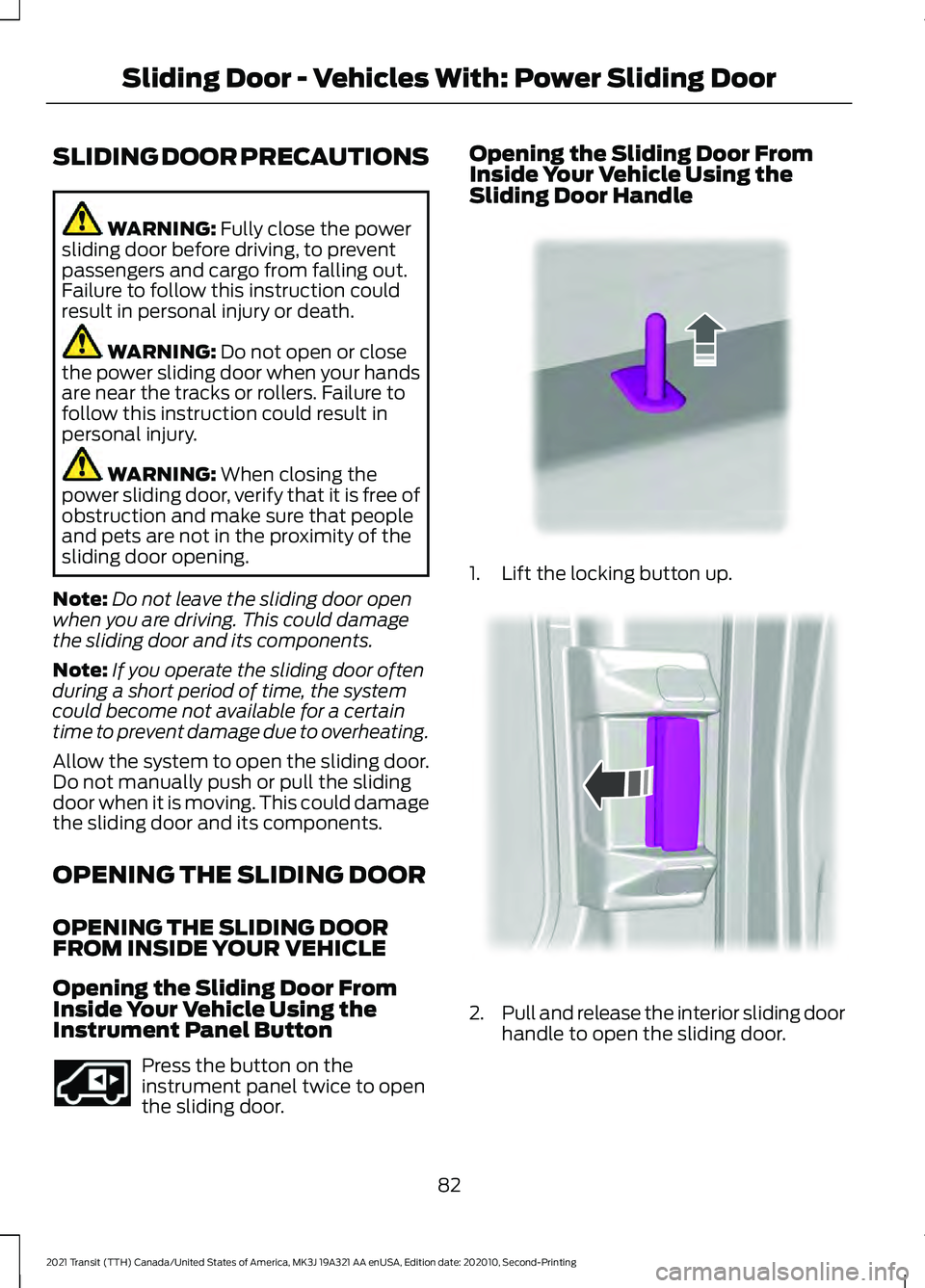
SLIDING DOOR PRECAUTIONS
WARNING: Fully close the power
sliding door before driving, to prevent
passengers and cargo from falling out.
Failure to follow this instruction could
result in personal injury or death. WARNING:
Do not open or close
the power sliding door when your hands
are near the tracks or rollers. Failure to
follow this instruction could result in
personal injury. WARNING:
When closing the
power sliding door, verify that it is free of
obstruction and make sure that people
and pets are not in the proximity of the
sliding door opening.
Note: Do not leave the sliding door open
when you are driving. This could damage
the sliding door and its components.
Note: If you operate the sliding door often
during a short period of time, the system
could become not available for a certain
time to prevent damage due to overheating.
Allow the system to open the sliding door.
Do not manually push or pull the sliding
door when it is moving. This could damage
the sliding door and its components.
OPENING THE SLIDING DOOR
OPENING THE SLIDING DOOR
FROM INSIDE YOUR VEHICLE
Opening the Sliding Door From
Inside Your Vehicle Using the
Instrument Panel Button Press the button on the
instrument panel twice to open
the sliding door. Opening the Sliding Door From
Inside Your Vehicle Using the
Sliding Door Handle
1. Lift the locking button up.
2.
Pull and release the interior sliding door
handle to open the sliding door.
82
2021 Transit (TTH) Canada/United States of America, MK3J 19A321 AA enUSA, Edition date: 202010, Second-Printing Sliding Door - Vehicles With: Power Sliding DoorE293692 E310708 E148804
Page 89 of 509
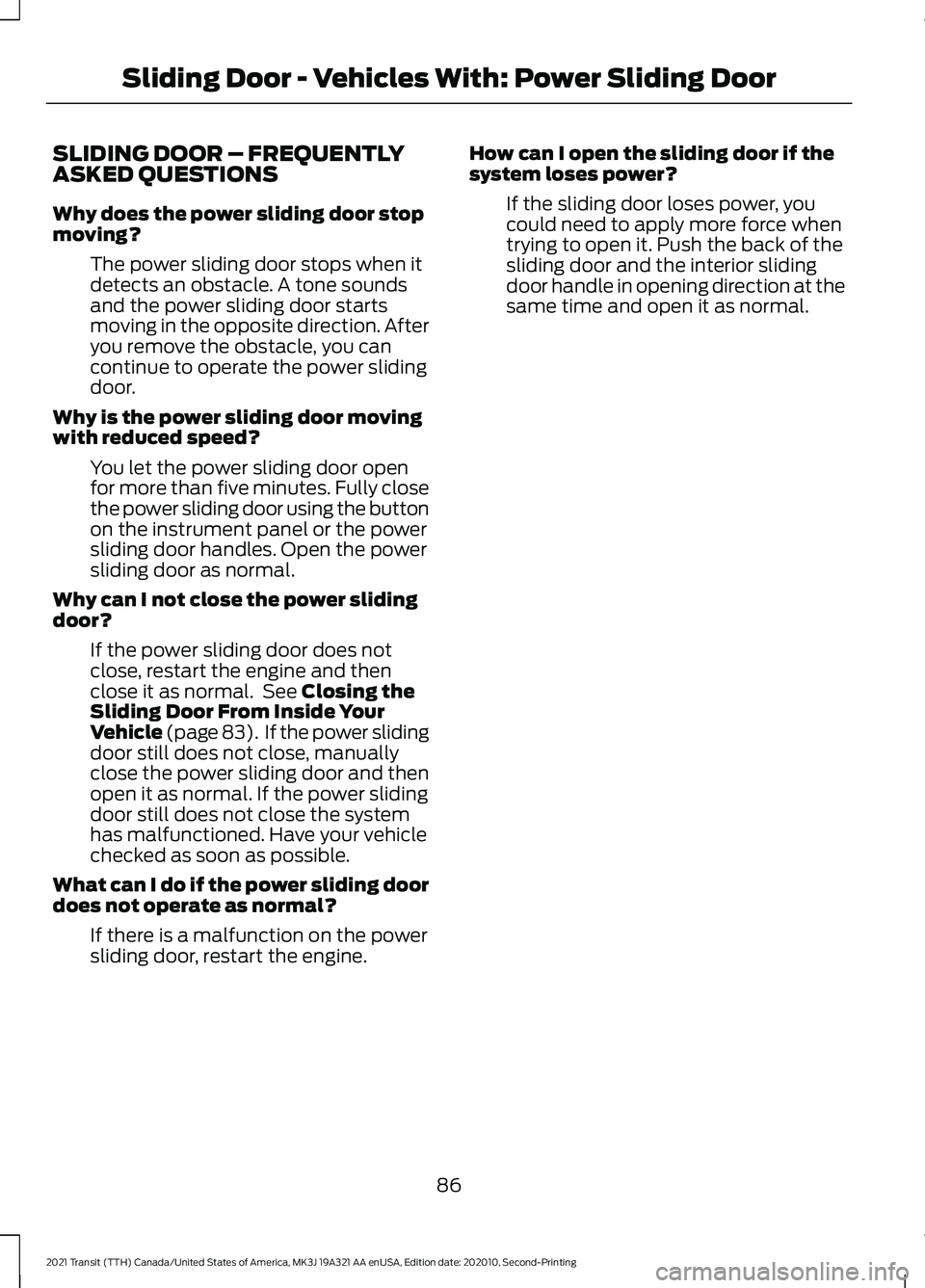
SLIDING DOOR – FREQUENTLY
ASKED QUESTIONS
Why does the power sliding door stop
moving?
The power sliding door stops when it
detects an obstacle. A tone sounds
and the power sliding door starts
moving in the opposite direction. After
you remove the obstacle, you can
continue to operate the power sliding
door.
Why is the power sliding door moving
with reduced speed? You let the power sliding door open
for more than five minutes. Fully close
the power sliding door using the button
on the instrument panel or the power
sliding door handles. Open the power
sliding door as normal.
Why can I not close the power sliding
door? If the power sliding door does not
close, restart the engine and then
close it as normal. See Closing the
Sliding Door From Inside Your
Vehicle (page 83). If the power sliding
door still does not close, manually
close the power sliding door and then
open it as normal. If the power sliding
door still does not close the system
has malfunctioned. Have your vehicle
checked as soon as possible.
What can I do if the power sliding door
does not operate as normal? If there is a malfunction on the power
sliding door, restart the engine. How can I open the sliding door if the
system loses power?
If the sliding door loses power, you
could need to apply more force when
trying to open it. Push the back of the
sliding door and the interior sliding
door handle in opening direction at the
same time and open it as normal.
86
2021 Transit (TTH) Canada/United States of America, MK3J 19A321 AA enUSA, Edition date: 202010, Second-Printing Sliding Door - Vehicles With: Power Sliding Door
Page 103 of 509
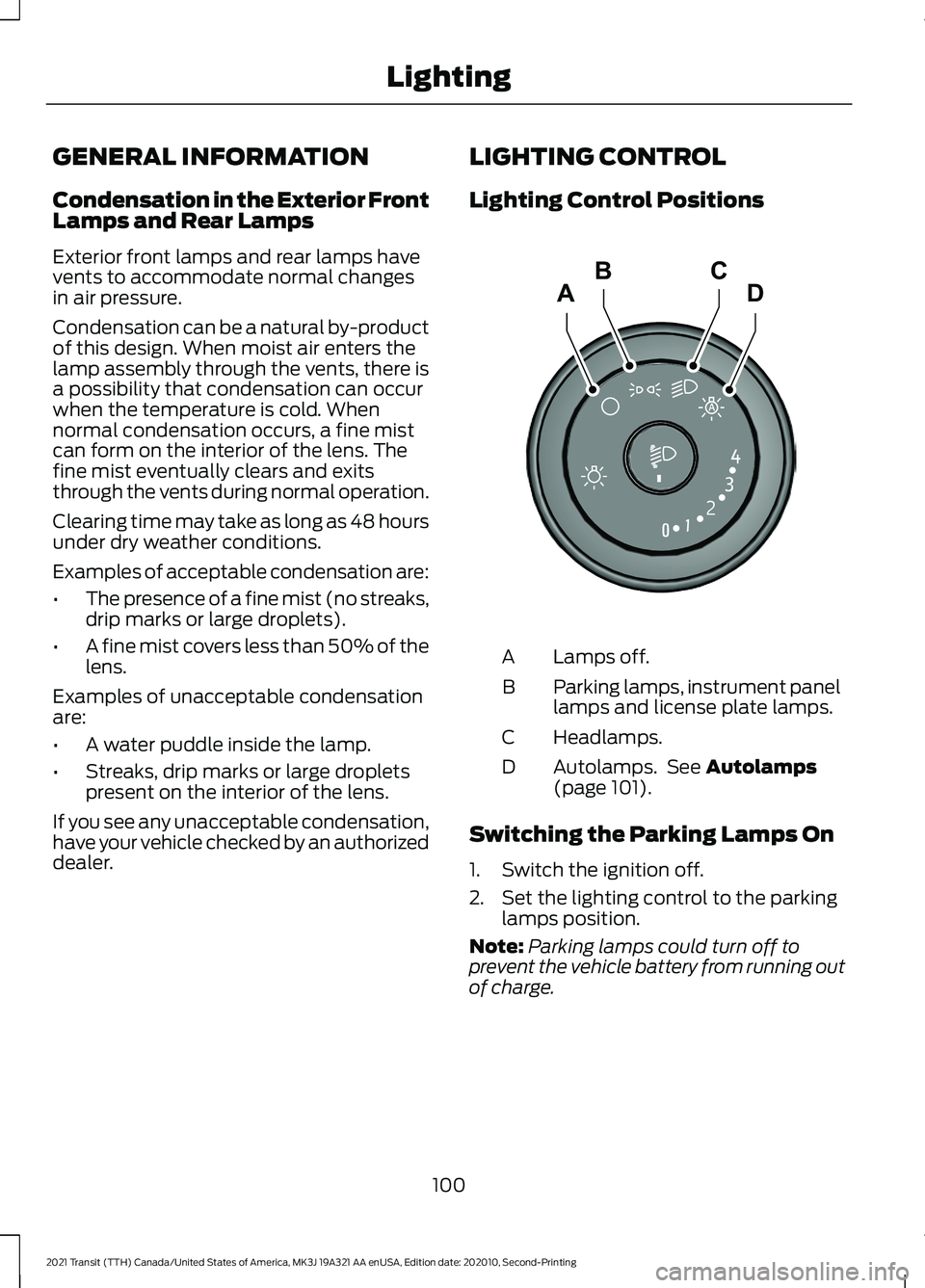
GENERAL INFORMATION
Condensation in the Exterior Front
Lamps and Rear Lamps
Exterior front lamps and rear lamps have
vents to accommodate normal changes
in air pressure.
Condensation can be a natural by-product
of this design. When moist air enters the
lamp assembly through the vents, there is
a possibility that condensation can occur
when the temperature is cold. When
normal condensation occurs, a fine mist
can form on the interior of the lens. The
fine mist eventually clears and exits
through the vents during normal operation.
Clearing time may take as long as 48 hours
under dry weather conditions.
Examples of acceptable condensation are:
•
The presence of a fine mist (no streaks,
drip marks or large droplets).
• A fine mist covers less than 50% of the
lens.
Examples of unacceptable condensation
are:
• A water puddle inside the lamp.
• Streaks, drip marks or large droplets
present on the interior of the lens.
If you see any unacceptable condensation,
have your vehicle checked by an authorized
dealer. LIGHTING CONTROL
Lighting Control Positions
Lamps off.
A
Parking lamps, instrument panel
lamps and license plate lamps.
B
Headlamps.
C
Autolamps. See Autolamps
(page 101).
D
Switching the Parking Lamps On
1. Switch the ignition off.
2. Set the lighting control to the parking lamps position.
Note: Parking lamps could turn off to
prevent the vehicle battery from running out
of charge.
100
2021 Transit (TTH) Canada/United States of America, MK3J 19A321 AA enUSA, Edition date: 202010, Second-Printing LightingADCBE245649
Page 126 of 509
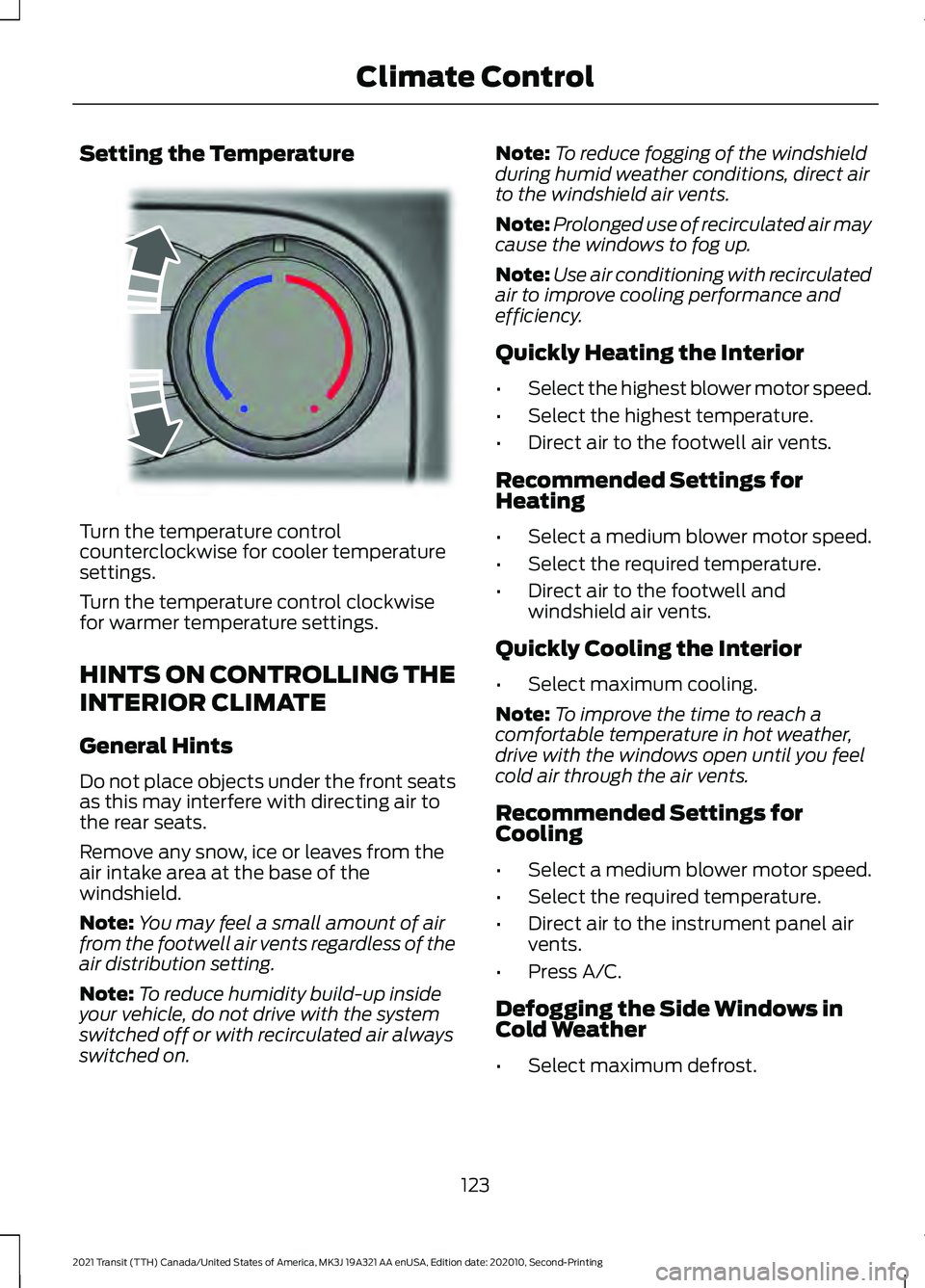
Setting the Temperature
Turn the temperature control
counterclockwise for cooler temperature
settings.
Turn the temperature control clockwise
for warmer temperature settings.
HINTS ON CONTROLLING THE
INTERIOR CLIMATE
General Hints
Do not place objects under the front seats
as this may interfere with directing air to
the rear seats.
Remove any snow, ice or leaves from the
air intake area at the base of the
windshield.
Note:
You may feel a small amount of air
from the footwell air vents regardless of the
air distribution setting.
Note: To reduce humidity build-up inside
your vehicle, do not drive with the system
switched off or with recirculated air always
switched on. Note:
To reduce fogging of the windshield
during humid weather conditions, direct air
to the windshield air vents.
Note: Prolonged use of recirculated air may
cause the windows to fog up.
Note: Use air conditioning with recirculated
air to improve cooling performance and
efficiency.
Quickly Heating the Interior
• Select the highest blower motor speed.
• Select the highest temperature.
• Direct air to the footwell air vents.
Recommended Settings for
Heating
• Select a medium blower motor speed.
• Select the required temperature.
• Direct air to the footwell and
windshield air vents.
Quickly Cooling the Interior
• Select maximum cooling.
Note: To improve the time to reach a
comfortable temperature in hot weather,
drive with the windows open until you feel
cold air through the air vents.
Recommended Settings for
Cooling
• Select a medium blower motor speed.
• Select the required temperature.
• Direct air to the instrument panel air
vents.
• Press A/C.
Defogging the Side Windows in
Cold Weather
• Select maximum defrost.
123
2021 Transit (TTH) Canada/United States of America, MK3J 19A321 AA enUSA, Edition date: 202010, Second-Printing Climate ControlE244106